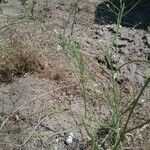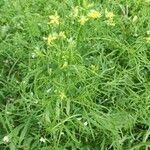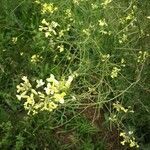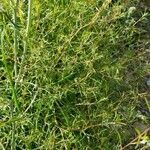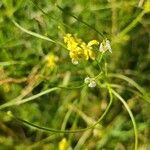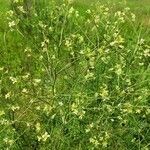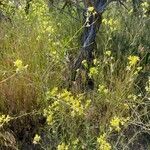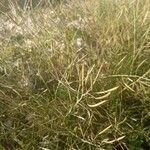Annuals; glabrous or pubescent. Stems erect, branched distally, (2-)4-12(-16) dm, sparsely to densely hirsute basally, glabrous or glabrate distally. Basal leaves rosulate; petiole 1-10(-15) cm; blade broadly oblanceolate, oblong, or lanceolate (in outline), (2-)5-20(-35) cm × (10-)20-80(-100) mm, margins pinnatisect, pinnatifid, or runcinate; lobes (3-)4-6(-8) on each side, oblong or lanceolate, smaller than terminal lobe, margins entire, dentate, or lobed. Cauline leaves similar to basal; distalmost blade with linear to filiform lobes. Fruiting pedicels usually divaricate, rarely ascending, stout, nearly as wide as fruit, (4-)6-10(-13) mm. Flowers: sepals ascending or spreading, oblong, (cucullate), 4-6 × 1-2 mm; petals spatulate, (5-)6-8(-10) × 2.5-4 mm, claw 3.5-6 mm; filaments 2-6 mm; anthers oblong, 1.5-2.2 mm. Fruits narrowly linear, usually straight, smooth, stout, (4.5-)6-9(-12) cm × 1-2 mm; valves glabrous; ovules 90-120 per ovary; style 0.5-2 mm; stigma prominently 2-lobed. Seeds 0.8-1 × 0.5-0.6 mm. 2n = 14.
Annual herb. Stem erect, hairy at base, to 1 m tall. Rosette and lower stem lvs sparsely hispid especially below, pinnatifid, rarely almost 2-pinnatifid, 5-15-(30) × 1.5-7-(10) cm, with 5-9-(12) pairs of toothed triangular lobes. Upper stem lvs glabrous, smaller, pinnatifid with linear-filiform segments. Racemes often flexuous, ebracteate, suberect or spreading, glabrous, 10-30 cm long. Pedicels c. 5 mm long at flowering, elongating to up to c. 10 mm long at fruiting, glabrous. Sepals glabrous, 3-4 mm long, the outer pair with short horn at apex (most conspicuous in bud). Petals yellow, 6-8 mm long. Anthers at least 1 mm long; filaments = or slightly > sepals. Silique glabrous, spreading, linear-cylindric, (40)-70-110 × 1-1.5 mm; style 0.5-1 mm long. Seeds ovoid to oblong, brown, c. 0.8 mm long.
Erect, to 1 m, commonly simple below and much-branched above, glabrous or sparsely pilose; lvs petioled, pinnatifid, the lower with 5–8 pairs of linear and entire to lanceolate and serrate segments, the upper small, with fewer segments; pet pale yellow, 6–8 mm; pedicels nearly or quite as thick as the fr, ascending, 5–10 mm; frs ascending or spreading, slender, 5–10 cm × 1–1.5 mm; 2n=14. Native of Eurasia, established as a weed of fields and waste places throughout most of the U.S. and adj. Can., especially northward. June–Aug. (Norta a.)
A cabbage family herb. It grows 40-120 cm tall. The stems are erect and branched above. The leaves at the base are in a ring. The leaves are oblong and can be divided. They are 5-20 cm long by 2-8 cm wide. The flowers are yellow. The seeds are 1 mm long by 0.5 mm wide.
